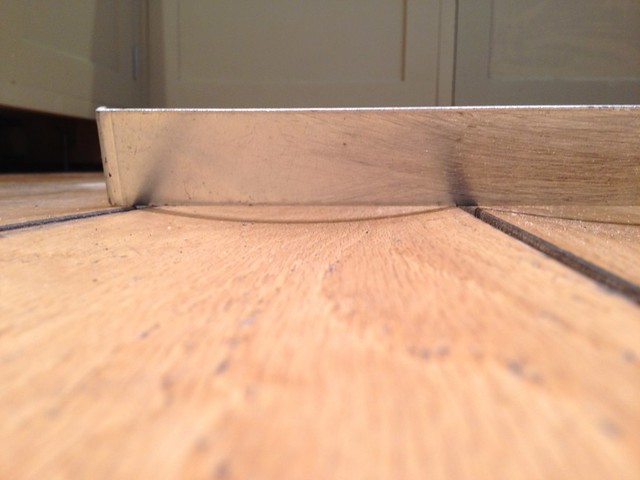petermillard
Established Member
Hey folks.
Customer's just contacted me regarding some problems he's having with a hardwood floor in his kitchen - it was laid (not by me) about 12-13 years ago, and recently (over the course of the last few months) the boards have starting moving and cupping, and now look like this:-



All my instincts are screaming 'water damage from underneath' but having lifted one of the boards this morning there's no real sign of anything obvious; the underside of the boards are as dry as the top sides, the moisture level in the cement substrate, whilst a little high, seems consistent across all the areas that I could reach. Obviously it's a kitchen, so there are all kinds of water and waste pipes around the backs of the cabinets, but as far as I can ascertain none of these are currently leaking, and show no obvious signs of having leaked.
So I'm a bit stumped; the boards are held together with thin metal clips, and those that I've exposed do show some signs of surface rust (and you can see a kind of 'tide-mark' stain towards the bottom of the lifted board in the last photo above) so my water theory is still my favourite, but if anyone has any idea what else might have caused this kind of movement, or if anyone's experienced anything like it before, I'd be glad to hear about it.
And second question: I haven't come across this type of floor before, where it's all held together with metal clips - is this something that's currently available, or just something that was popular a decade or so back? And how do you lift the boards without mucking everything up??
As always, all info and opinion much appreciated.
Cheers, Pete
Customer's just contacted me regarding some problems he's having with a hardwood floor in his kitchen - it was laid (not by me) about 12-13 years ago, and recently (over the course of the last few months) the boards have starting moving and cupping, and now look like this:-



All my instincts are screaming 'water damage from underneath' but having lifted one of the boards this morning there's no real sign of anything obvious; the underside of the boards are as dry as the top sides, the moisture level in the cement substrate, whilst a little high, seems consistent across all the areas that I could reach. Obviously it's a kitchen, so there are all kinds of water and waste pipes around the backs of the cabinets, but as far as I can ascertain none of these are currently leaking, and show no obvious signs of having leaked.
So I'm a bit stumped; the boards are held together with thin metal clips, and those that I've exposed do show some signs of surface rust (and you can see a kind of 'tide-mark' stain towards the bottom of the lifted board in the last photo above) so my water theory is still my favourite, but if anyone has any idea what else might have caused this kind of movement, or if anyone's experienced anything like it before, I'd be glad to hear about it.
And second question: I haven't come across this type of floor before, where it's all held together with metal clips - is this something that's currently available, or just something that was popular a decade or so back? And how do you lift the boards without mucking everything up??
As always, all info and opinion much appreciated.
Cheers, Pete

































